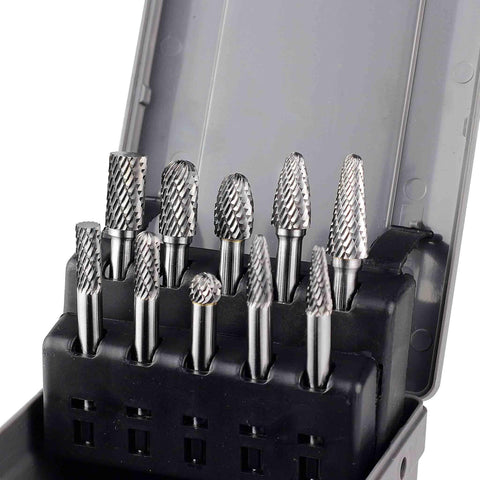Exploring the Versatility of Tungsten Carbide Burrs: A Guide to Different Types
Tungsten carbide burrs are essential tools for metalworkers, machinists, and craftsmen working across a variety of industries. These rotary cutting tools, made from tungsten carbide, are known for their superior hardness and durability, capable of cutting, shaping, and grinding even the toughest materials. Whether you're working with steel, aluminum, iron, or other metals, tungsten carbide burrs are designed to handle high levels of stress, maintaining their sharpness and precision throughout prolonged use. What makes tungsten carbide burrs so versatile is the variety of shapes and cutting styles available, each tailored to specific tasks and applications. Choosing the right burr for a job ensures efficiency, accuracy, and a high-quality finish.One of the most commonly used types of tungsten carbide burrs is the cylindrical burr. As the name suggests, these burrs have a cylindrical shape and are ideal for working on flat surfaces. Cylindrical burrs are often used for tasks like surface grinding, deburring, and removing excess material from welds. Their straight edges allow for even material removal, making them perfect for achieving a smooth, consistent finish on flat or slightly curved metal surfaces. Whether prepping a metal piece for further machining or smoothing out a rough weld, cylindrical burrs are highly effective for broad surface work where precision and uniformity are essential.
Ball-shaped tungsten carbide burrs offer a different advantage, particularly when working on curved surfaces or complex shapes. The spherical design of ball burrs allows them to cut smoothly and evenly over concave or convex areas, making them perfect for fine detailing, engraving, or shaping tasks. Ball burrs are frequently used in industries where intricate metalwork is required, such as toolmaking, automotive repair, and jewelry design. Their ability to work on rounded edges and hard-to-reach places makes them indispensable when precision is critical, especially for tasks involving delicate curves or recessed areas.
Cone-shaped tungsten carbide burrs are another popular option for a wide range of metalworking tasks. The tapered shape of these burrs allows them to reach into tight spaces and create sharp angles or grooves. Cone burrs are often used for chamfering edges, creating bevels, or drilling small holes in metal surfaces. Their pointed or rounded tips provide excellent control, making them ideal for detailed work where accuracy is paramount. Cone-shaped burrs are especially valuable in mold-making, die-casting, and precision tool manufacturing, where the ability to create smooth, precise cuts in confined spaces is essential.
Tree-shaped tungsten carbide burrs, which come in both pointed and rounded varieties, are perfect for working on internal cuts or shaping intricate designs. The pointed tree burr is particularly effective for making sharp grooves or cutting into narrow channels, while the rounded tree burr is ideal for contouring and smoothing curved surfaces. These burrs are commonly used in tasks that require precision in hard-to-reach areas, such as die-making or finishing complex castings. Tree-shaped burrs are also useful for metal sculpting or detailed repair work, where a combination of aggressive cutting and fine shaping is necessary.
Flame-shaped tungsten carbide burrs are designed for versatility, providing both speed and precision when working on metal surfaces. Their elongated, tapered design makes them perfect for working on irregular shapes or curved surfaces, where controlled material removal is required. Flame burrs are often used in industries like automotive repair or metal fabrication, where components need to be shaped and finished without compromising their structural integrity. These burrs are also favored in artistic metalworking and sculpting, where complex shapes must be carefully crafted and refined.
In addition to these various shapes, the cutting pattern of tungsten carbide burrs plays an important role in determining their effectiveness for specific tasks. Double-cut burrs, which feature a crisscross cutting pattern, are especially useful for working with harder materials like stainless steel or cast iron. The double-cut pattern reduces vibrations, allowing for smoother cuts and providing a finer finish. This makes double-cut burrs ideal for tasks that require precision and a polished look, such as finishing work on molds or castings. Single-cut burrs, on the other hand, have a more aggressive cutting action and are best suited for rapid material removal, particularly on softer metals like aluminum or brass.
Choosing the right type of tungsten carbide burr is essential for achieving the best results in any metalworking project. Each shape and cutting style is designed to perform specific tasks, from rough material removal to intricate detailing and finishing. Whether you're working on flat surfaces with cylindrical burrs, shaping complex curves with ball burrs, or creating sharp grooves with cone burrs, the versatility of tungsten carbide burrs ensures that you have the right tool for the job. Their exceptional hardness and durability make them invaluable for both industrial applications and fine metalwork, delivering consistent performance even in the most demanding conditions.
Tungsten carbide burrs are key to achieving precision, efficiency, and a professional finish in metalworking projects. By selecting the appropriate burr shape and cutting pattern for the task at hand, craftsmen and professionals alike can take full advantage of the capabilities these tools offer, ensuring successful outcomes on a wide variety of materials and surfaces..



